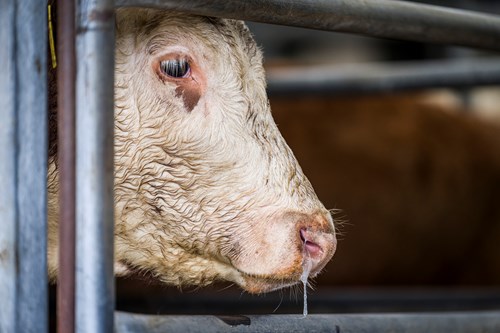Bovine Respiratory Disease (BRD)

Bovine Respiratory Disease (BRD) (commonly known as pneumonia) is a multifactorial and highly infectious disease of the lower respiratory tract of cattle. It is a significant health, welfare and productivity issue in both beef and dairy herds. Disease is more commonly recognised in younger animals and can result in increased deaths as well as long-term impact on growth rates.
The incidence and severity of disease relate to balance between:

Disease occurs when the challenge of infection from the pathogens (causal agents such as viruses and/or bacteria) overwhelms the immune defences of the animal. Many of the agents implicated in disease are already present in the animals or on the farm. Often the primary infection is caused by a virus which causes lung damage which then allows a secondary bacterial infection to develop.
The main pathogens:

Animal factors to consider include:
- Colostrum management – key to a good start and providing initial passive immunity.
- Calves with inadequate colostral intake (failure of passive transfer) are 3.2 – 9.5 times more likely to get sick and 5.4 times more likely to die.
- Reducing stress. Stressors are cumulative and reduce performance. It is important to minimise the different potential stressors (listed below) as much as possible to reduce incidence and severity of disease.
- Mixing with other animals
- Different ages or sources
- Handling collection increases risk of disease transmission
- Management stressors:
- Weaning
- Castration
- Disbudding/dehorning
Environmental factors:
The environment can have an impact on the animals and the pathogens that cause disease.
Areas for consideration include:
- Temperature – animals of different ages have different thermoneutral zones which decrease with age. The thermoneutral zone is the temperature range in which animals do not need to expend energy to keep warm and is not too hot.
- Air quality and speed – air needs to be clean (not dusty) and regularly changing to prevent the build of pathogens but with no draughts directly on the animal.
- Moisture - bacteria thrive in moist conditions so reducing the level of moisture as much as possible in housing is best practice. It is especially important that young calves have dry bedding provided.
Overall, a well-designed shed can have a significant impact on the health of the animals that will be housed in it. Ventilation is a particularly important consideration.
Clinical signs and impact:
The clinical signs of pneumonia are well documented and include eye and nose discharge, a reduction in vigour and appetite as well as coughing.
What is less obvious is that if you see the overt signs mentioned above in a group of calves, there are likely to be many other animals affected that are not showing signs. These sub-clinically affected animals will still have a decrease in productivity especially daily live wight gain (DLWG). Calves that have lung lesions detected in the abattoir tend to have taken longer to finish due to the decrease in DLWG (this can be up to 500g/day) and decreased feed intake and conversion efficiency.
In beef calves, the overall costs have been estimated to be £128 per moderately affected calf and £263 per severely affected calf, with the biggest impact being the decrease in growth rates.
Early detection and prompt treatment (as advised by your vet) will reduce the impact of disease, but PREVENTION is best.
Prevention:
- Assess housing to ensure fit for purpose and ventilation is adequate for stocking densities.
- Avoid mixing of animals form different sources and of different ages.
- Ensure nutrition is appropriate for age of animal and water is freely available.
- Reduce stress in animals, preparation to minimise stress at weaning is especially important.
- A wide range of vaccines are available – please discuss with your vet and ensure that any disease outbreaks are investigated to allow your herd health plan to be updated with the most suitable vaccine protocols.
There is funding available through the preparation for sustainable farming interventions. The calf respiratory investigation has options to investigate the pathogens and or the environmental/housing considerations followed by the completion of an expert adviser form.

Useful Resources
- Pneumonia in beef cattle: TN571.indd
- BRP+ Better management of bovine respiratory disease
- PSF Animal Health & Welfare - Cattle
Kythe Mackenzie, Veterinary Investigation Officer, kythe.mackenzie@sruc.ac.uk

Unearthed is the exclusive SAC Consulting members' monthly newsletter. Unearthed offers insights and tips from our experts on what we think is in store for farming and crofting in the coming months in order to protect and enhance your business.
Posted by Unearthed News on 16/10/2024
